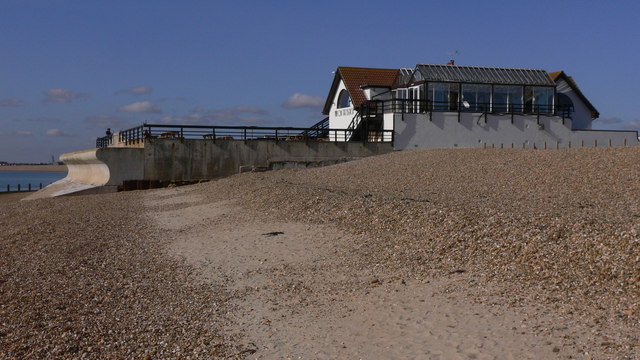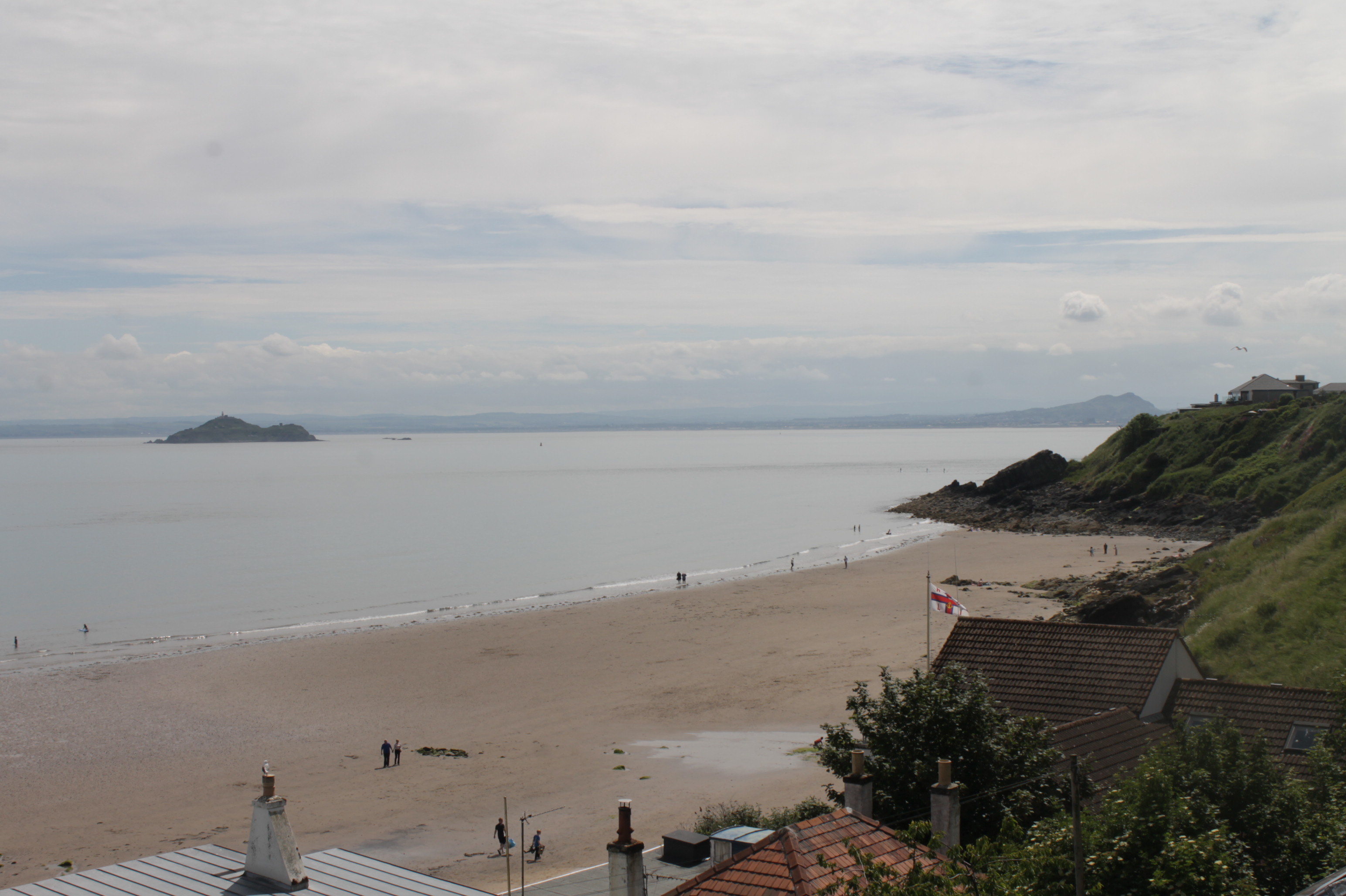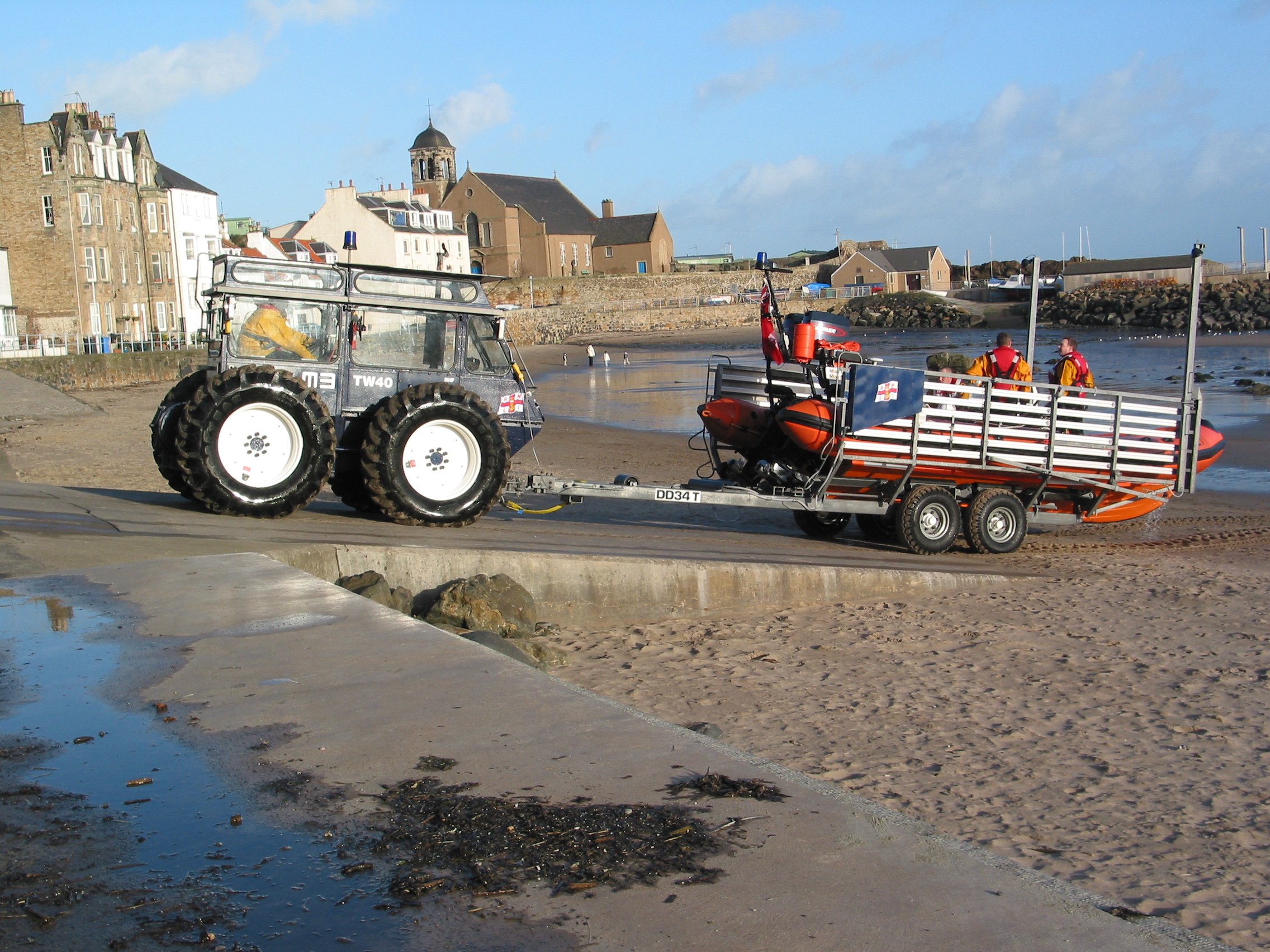|
Talus MB-764 Amphibious Tractor
Talus MB-764 is a four-wheel drive launch tractor which was specifically designed for the RNLI, to launch and recover inflatable inshore lifeboats from beach and shorebased launched lifeboat stations. The Tractor is produced by the British company of Clayton Engineering Limited who are based in Knighton, Powys.OS Explorer Map 201 - Knighton and Presteigne Tref-y-clawdd a Dyffryn Elan, Author: Ordnance Survey. Publisher: Ordnance Survey. Work: Folded Map. Development The MB-764 was the first launch tractor designed and developed in conjunction with the RNLI to launch the institutions smaller inshore inflatable lifeboat fleet. Clayton’s based the design of the MB-764 on Ford ''County Commercial Cars''. At the design and development stage the company presented two Prototype models. The first being the main take up by the RNLI. The first of these launch tractors went into service with the RNLI in 1975 and since then over 30 tractors have been operated by the Institute around th ... [...More Info...] [...Related Items...] OR: [Wikipedia] [Google] [Baidu] |
Royal National Lifeboat Institution
The Royal National Lifeboat Institution (RNLI) is the largest charity that saves lives at sea around the coasts of the United Kingdom, the Republic of Ireland, the Channel Islands, and the Isle of Man, as well as on some inland waterways. It is one of Independent lifeboats in Britain and Ireland, several lifeboat services operating in the same area. Founded in 1824 as the National Institution for the Preservation of Life from Shipwreck, soon afterwards becoming the Royal National Institution for the Preservation of Life from Shipwreck, under the patronage of King George IV. On 5 October 1854, the institution’s name was changed to its current name (RNLI), and in 1860 was granted a royal charter. The RNLI is a charity in the UK and in the Republic of Ireland and has enjoyed royal patronage since its foundation, the most recent being Elizabeth II of the United Kingdom, Queen Elizabeth II until her death on 8 September 2022. The RNLI is principally funded by Will (law), legacie ... [...More Info...] [...Related Items...] OR: [Wikipedia] [Google] [Baidu] |
Lymington Lifeboat Station
Lymington is a port town on the west bank of the Lymington River on the Solent, in the New Forest district of Hampshire, England. It faces Yarmouth, Isle of Wight, to which there is a car ferry service operated by Wightlink. It is within the civil parish of Lymington and Pennington. The town has a large tourist industry, based on proximity to the New Forest and its harbour. It is a major yachting centre with three marinas. As of 2015, the parish of Lymington and Pennington had a population of 15,726. History The earliest settlement in the Lymington area was around the Iron Age hill fort known today as Buckland Rings. The hill and ditches of the fort survive, and archaeological excavation of part of the walls was carried out in 1935. The fort has been dated to around the 6th century BC. There is another supposed Iron Age site at nearby Ampress Hole. However, evidence of later settlement there (as opposed to occupation) is sparse before ''Domesday book'' (1086). Lymington i ... [...More Info...] [...Related Items...] OR: [Wikipedia] [Google] [Baidu] |
Hayling Island Lifeboat Station
Hayling Island Lifeboat Station is a Royal National Lifeboat Institution station located on Hayling Island close to the town of Mengham in the English county of Hampshire. The station is located on the eastern side of Hayling island at the entrance to Chichester Harbour where it joins the major shipping route of the Solent, and is opposite the village of West Wittering. This major shipping route is busy at all times of the year and there are estimated to be 10,000 boats in the Chichester area alone. The Hayling Island station provides cover for the area 24 hours a day, all year, by means of two inshore rigid inflatable lifeboats placed on this station. History 1865–1924: original station The Royal National Lifeboat Institution (RNLI) first opened a lifeboat station on Hayling Island in 1865 after a pair of marine incidents in 1862 and 1865 made it clear that regular lifeboat coverage was required at Hayling. In each incident, local fishermen had been required to step ... [...More Info...] [...Related Items...] OR: [Wikipedia] [Google] [Baidu] |
Youghal Lifeboat Station
Youghal ( ; ) is a seaside resort town in County Cork, Ireland. Located on the estuary of the River Blackwater, the town is a former military and economic centre. Located on the edge of a steep riverbank, the town has a long and narrow layout. As of the 2016 census, the population was 7,963. As a historic walled seaport town on the coastline of East Cork, and close to a number of beaches, it has been a tourist destination since the mid-19th century. There are a number of historic buildings and monuments within the town's walls, and Youghal is among a small number of towns designated as "Irish Heritage Ports" by the Irish Tourist Board. Name The name ''Youghal'' comes from the Irish ''Eochaill'' meaning "yew woods", which were once common in the area. Older anglicisations of this name include ''Youghall'', ''Yoghel'' and ''Yochil''. History and architecture Youghal received its charter of incorporation in 1209, but the history of settlement on the site is longer, with Viking s ... [...More Info...] [...Related Items...] OR: [Wikipedia] [Google] [Baidu] |
Portishead Lifeboat Station
Portishead Lifeboat Station (based in Portishead, Somerset) opened in 1995 as Portishead Lifeboat Trust, an independent lifeboat operating from Sugar Loaf Bay. It was adopted by the Royal National Lifeboat Institution (RNLI) in 2015 when a new lifeboat station was opened adjacent to Portishead Pier. The station currently (2019) operates a RNLB ''My Lady Anne'' (B-884) with around 40 volunteer crew. History A rescue service in the waters off Portishead was provided from 1967 until 1992 by Portishead Yacht Club. The Portishead Lifeboat Trust was established as a charity in 1995 to provide a replacement service. Their first lifeboat was operational from 6 October 1996 using a base at the Yacht Club's premises in Sugar Loaf Bay to the south of the town. On 28 August 2008 the lifeboat crew were undertaking a training exercise when the lifeboat was damaged by heavy seas. Their 'mayday' was answered by the RNLI lifeboat from and the Severn Area Rescue Association (SARA). The Portis ... [...More Info...] [...Related Items...] OR: [Wikipedia] [Google] [Baidu] |
Kinghorn Lifeboat Pulled By Its Tractor - Geograph
Kinghorn (; gd, Ceann Gronna) is a town and parish in Fife, Scotland. A seaside resort with two beaches, Kinghorn Beach and Pettycur Bay, plus a fishing port, it stands on the north shore of the Firth of Forth, opposite Edinburgh. According to the 2008 population estimate, the town has a population of 2,930. Known as the place where King Alexander III of Scotland died, it lies on the A921 road and the Fife Coastal Path. Kinghorn railway station is on the Edinburgh to Aberdeen and Fife Circle railway lines. Kinghorn only has a primary school, so high school pupils must travel by bus to Balwearie High School in Kirkcaldy. The town's lifeboat station is one of Scotland's busiest - regularly getting called out to all sorts of emergencies in the Firth. Currently stationed at Kinghorn is an Atlantic 85 inshore lifeboat, B-836 "Tommy Niven". The civil parish has a population of 4,201 (in 2011). Burntisland was in the past referred to as Little Kinghorn or Wester Kinghorn. Hist ... [...More Info...] [...Related Items...] OR: [Wikipedia] [Google] [Baidu] |
Kinghorn Lifeboat Station
Kinghorn Lifeboat Station is a RNLI station located in the town of Kinghorn in Fife, Scotland. The station is currently equipped with an Atlantic 85 inshore lifeboat bearing the name ''Tommy Niven.'' The station is open most weekends in the summer for visitors. History Kinghorn Lifeboat station was established in 1965 by the RNLI to help provide more cover in the Firth of Forth as more leisure craft became deployed in the area at that time. Initially a small shed structure made from Hardun wood was built which housed a D-class lifeboat which operated in summer months only. The boat was launched by hand across Kinghorn beach. The first launch of the boat in 1965 saw the crew deliver letters to residents of Inchkeith and Inchcolm to inform them of the station being built. In 1982 a new pre-cast boathouse was built to replace the previous wooden structure. On 10 June 1985 the station received a new twin-engine with the registration mark (C-514). This boat was also accompanied w ... [...More Info...] [...Related Items...] OR: [Wikipedia] [Google] [Baidu] |
Clifden Lifeboat Station
Clifden (, meaning "stepping stones") is a coastal town in County Galway, Ireland, in the region of Connemara, located on the Owenglin River where it flows into Clifden Bay. As the largest town in the region, it is often referred to as "the Capital of Connemara". Frequented by tourists, Clifden is linked to Galway city by the N59. History 19th century The town was founded at the start of the 19th century by John D'Arcy (1785–1839) who lived in Clifden Castle (built around 1818, now a ruin) west of Clifden. He had inherited the estate in 1804 when it was mostly inhabited by fishermen and farmers. The idea of establishing a town on the coast was first voiced by him in 1812. Bad communications and a lack of private capital prevented fast progress until the 1820s when the potato crop failed in 1821–22 and D'Arcy petitioned the government in Dublin for assistance. The engineer Alexander Nimmo was sent to the area in 1822. He constructed a quay at Clifden (finished in 1831) and s ... [...More Info...] [...Related Items...] OR: [Wikipedia] [Google] [Baidu] |
Tighnabruaich Lifeboat Station
Tighnabruaich Lifeboat Station is located in the Kyles of Bute. It has been in use for nearly 40 years. The inshore lifeboat carries out rescues mainly to leisure craft. The station is the base for Royal National Lifeboat Institution (RNLI) search and rescue operations at Tighnabruaich Tighnabruaich; (; gd, Taigh na Bruaich) is a village on the Cowal peninsula, on the western arm of the Kyles of Bute in Argyll and Bute, Scotland. In 2011 the population was 660. It is west of Glasgow and north of the Isle of Arran. Tighnabru ..., Argyll, United Kingdom. It operates an Atlantic 85 inshore Lifeboat (ILB). Fleet References Lifeboat stations in Scotland Kyles of Bute Water transport in Scotland {{Argyll-geo-stub ... [...More Info...] [...Related Items...] OR: [Wikipedia] [Google] [Baidu] |
Talus MB-764 (TW34) Kessock
Talus may refer to: Fictional entities * Talos or Talus, a bronze giant in Greek mythology * Talus, a young champion in '' Paladins: Champions of the Realm'' * Talus, a fictional planet in ''Star Wars'' * Talus, a character in ''The Faerie Queene'' by Edmund Spenser * Talus, an enemy in '' The Legend of Zelda: Breath of the Wild'' made of animated stone Other uses * Talus (fortification), a sloped portion of a fortified wall * Talus slope or deposit, a slope formed by an accumulation of broken rock debris, as at the base of a cliff or other high place, also called scree * Talus, an electronic design automation tool by Magma Design Automation * Talus bone, an ankle bone See also *Tallis (other) * Tallus The Exiles are a group of fictional characters appearing in American comic books published by Marvel Comics commonly associated with The X-Men. They feature in three series, '' Exiles'', ''New Exiles'', and ''Exiles'' vol. 2. The Exiles consists ..., a communications d ... [...More Info...] [...Related Items...] OR: [Wikipedia] [Google] [Baidu] |
Mudeford Lifeboat Station
Mudeford Lifeboat Station is the base for Royal National Lifeboat Institution (RNLI) search and rescue operations at Mudeford, Christchurch, Dorset in England. The first lifeboat was stationed on Mudeford Quay 1963 and the present station was opened in 2003. It operates an inshore lifeboat (ILB). History During the 1960s the RNLI deployed inflatable ILBs at places around the coast where a quick response to increasing numbers of leisure boats and water users could not be made by larger all-weather lifeboats (ALBs) at stations established to serve commercial shipping. Mudeford Quay, at the entrance to Christchurch Harbour, was selected as a suitable place and a small inflatable boat provided. This type of boat could only operate in relatively good conditions and were seldom used in the winter. As their usefulness was proven, some stations received an 'intermediate' ILB which could operate in more severe conditions. As early as 1970, Mudeford was one of the stations used to trial a ... [...More Info...] [...Related Items...] OR: [Wikipedia] [Google] [Baidu] |







